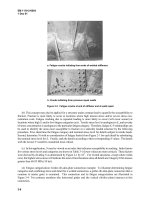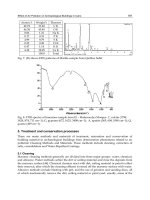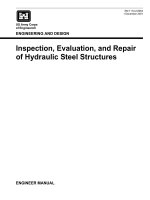Inspection Evaluation And Repair Of Steel structures Part 11 pot
Bạn đang xem bản rút gọn của tài liệu. Xem và tải ngay bản đầy đủ của tài liệu tại đây (425.5 KB, 10 trang )
EM 1110-2-6054
1 Dec 01
7-23
(3) In 1964, a new specification, ASTM A502, was published for steel structural rivets, and superseded
ASTM A141 and A195. The later version of this specification (ASTM A502) covers three grades of steel
rivets: general-purpose carbon steel rivets, carbon-manganese steel rivets for use with high-strength carbon
and high-strength low-alloy steels, and rivets comparable to ASTM A588 weathering steel. The later
specification includes hardness requirements but not tensile and yield strength requirements.
c. Allowable and yield stresses. During the same period that A7 steel was evolving, the American
Institute of Steel Construction (AISC) changed their basic allowable working stress for structural steel only
once, raising it in 1936 from 124 to 138 MPa (18 to 20 ksi) (Ferris 1953). The ASTM requirement for
minimum yield point during this period was generally one-half times the tensile strength, or not less than
207 MPa (30 ksi); in 1933, the minimum of 207 MPa (30 ksi) was raised to 227.5 MPa (33 ksi) for plate and
shape products. When A373 steel was introduced, that steel had a minimum yield point of 220.6 MPa (32 ksi),
suggesting that to improve weldability at that time, some sacrifice in strength was necessary. Only when A36
steel was introduced in 1960 in a tentative specification (ASTM A36-60T) did the minimum yield point for
structural steel plates and shapes increase to 248 MPa (36 ksi). By that time, weldability and welding practices
for structural steel had markedly improved and standardized.
d. Weldability of earlier steels.
(1) A very good reference that discusses the weldability of steels, including steels that have limited
weldability, is the monograph “Weldability of Steels” published by the Welding Research Council (Stout et al.
1987). Now in its fourth edition, the monograph has chapters on the properties of steel related to weldability,
factors affecting weldability in fabrication, and the weldability of different steels.
(2) For early steels, reference can be made to the first edition of the monograph (Stout and Doty 1953)
which includes suggested (as of 1953) welding practices for A7 steel meeting the tentative specification
ASTM A7-50T. However, even the first edition does not include data for A9 or A94 steels. A copy of the
suggested (1953) practices for A7 steel is listed in Table 7-1. For thicknesses up to 1 in. (the normal case for
hydraulic steel structures), a comparison of the recommended practices in Table 7-1 suggests that for carbon
levels of 0.25 percent or less, no special welding requirements are needed for A7 steel. However, as the carbon
level increases, more stringent practices are needed. Because A7 steel did not have a specified carbon level,
repair and maintenance welding should be conducted favoring the more stringent practices. For other early
steels or for steels of unknown specification, ANSI/AWS D1.1 provides optional methods for determining
welding requirements based on the chemical composition of the steel.
(3) A generally conservative practice for repair and maintenance welding on riveted spillway gates is to
use the practices for A7 steel in Table 7-1, with the assumption that the carbon level is between 0.26 and
0.30 percent.









